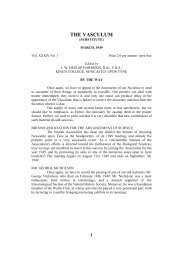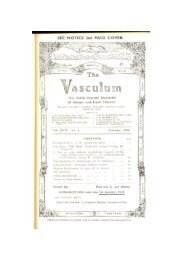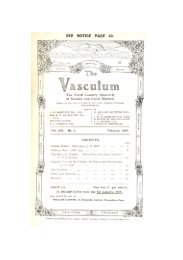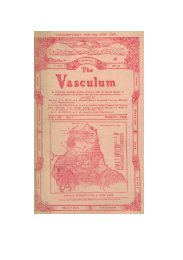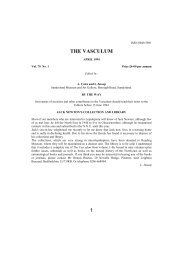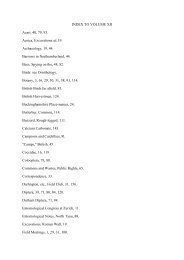1972 - The Vasculum
1972 - The Vasculum
1972 - The Vasculum
Create successful ePaper yourself
Turn your PDF publications into a flip-book with our unique Google optimized e-Paper software.
VASCULUM VOL. LVII. No. 3. <strong>1972</strong><br />
EDITORlAL<br />
17<br />
<strong>The</strong> existence of this, the second enlarged edition, is very largely due to very generous grants that<br />
we have received from the Royal Society, the University of Durham, and the University of Newcastle upon Tyne.<br />
On behalf of the Northern Naturalists' Union we thank these institutions for their timely generosity. <strong>The</strong> Royal<br />
Society has indicated that this is a once for all grant to help· us over the transitional period while we recruit new<br />
members to supply the extra cash. We trust that all members will note the position and act accordingly,<br />
<strong>The</strong> next enlarged edition planned for October 1973, may seem a long way off at present, but authors should begin<br />
thinking about it now, <strong>The</strong>y know full well the time it takes to prepare a paper. We would like to be earlier in our<br />
printting timetable, but it has not been possible this year due to several unforeseen delays. We apologise to all<br />
subscribers.<br />
CAREX AQUATlLlS WAHLENB. IN UPPER TEESDALE<br />
H. G. PROCTOR<br />
<strong>The</strong> Vicarage, Forest-in-Teesdale, Barnard Castle, Co. Durham,<br />
Previous British Records.<br />
Godwin (1956) states, of Carex aquatilis Wahlenberg, that "It belongs to Hulten's northern boreal circumpolar<br />
group which is absent from central Europe, and it is described by Polunin as a very widespread circurnpolar plant<br />
reaching the highest latitudes," Britton (1966), writing of Alaska above 70 N., states that a "Carex aquatilis -<br />
Marsh Type" vegetation is "exceedingly common on the Coastal Plain" near Point Barrow and "is estimated to<br />
cover about 25% of the Foothills" between the Coastal Plain and the Brooks Range, In the British Isles the species<br />
is at the southern limit of its range, and its rarity south of Scotland may be greater than the "Atlas of the British<br />
Flora" (Perring & WaIters, 1962) suggests, Mr. A. C. Jermy allows me to, quote from a letter in which he wrote,<br />
"<strong>The</strong> literature records at the turn of the century for Carex aquatilis in the lower reaches of the Tweed I am sure<br />
referred to C. acuta." It seems that suspicion also attaches to some of the Welsh and Irish records, For England,<br />
the "Atlas" shows, beside the suspect Northumbrian (i.e. Tweed) records, only a pre-1930 record for Cumberland,<br />
near Silloth, about the validity of which I have no Information, and a post-1930 record for Westmorland. It would<br />
seem, therefore, that the C. aquatilis plants - the determination of which was kindly confirmed by Mr. Jerrny - that<br />
grew in Upper Teesdale before they were destroyed during the construction of the Cow Green Reservoir, provided<br />
at best only the third and possibly only the second reliable record for England, In Scotland reliable records, as one<br />
would expect, are more frequent.<br />
Relic or Refugee.<br />
A feature of the Upper Teesdale flora which seems to appeal to the public is a possibility that some of its<br />
constituent species are relics of the Ice Age, and not all of them refugees from the forests which advanced over<br />
most of the country when the climate became more temperate, Carex aquatilis may have as a good a claim ,as any<br />
to ,the apparently more glamorous ,status of "relic," but satisfactory evidence of its continuous presence in the<br />
district since a tundra-type vegetatlon was the prevalent one is not yet to hand, <strong>The</strong>re, is a doubt whether<br />
macroscopic remains found on Cross Fell should be attributed to C. aquatilis or C. bigelowii but, whichever they<br />
were, they were placed, though with uncertainty in pollen zone VI (Godwin, 1956, p. 254, referring to Godwin<br />
& Clapham 1951).<br />
It is permissible, however, to wonder whether the influence of the large lake postulated by Dwerryhouse (1902)<br />
for the Maize Beck area at the height of the glaciation has been sufficiently taken into account in trying to assess<br />
Upper



